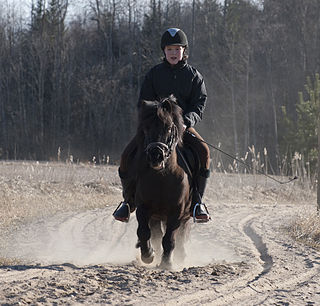
The Shetland pony is a Scottish breed of pony originating in the Shetland Islands in the north of Scotland. It may stand up to 107 cm (42 in) at the withers. It has a heavy coat and short legs, is strong for its size, and is used for riding, driving, and pack purposes.

A horse show is a judged exhibition of horses and ponies. Many different horse breeds and equestrian disciplines hold competitions worldwide, from local to the international levels. Most horse shows run from one to three days, sometimes longer for major, all-breed events or national and international championships in a given discipline or breed. Most shows consist of a series of different performances, called classes, wherein a group of horses with similar training or characteristics compete against one another for awards and, often, prize money.
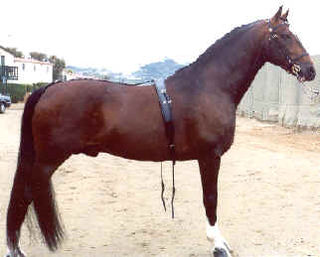
The Hackney is a recognized breed of horse that was developed in Great Britain. In recent decades, the breeding of the Hackney has been directed toward producing horses that are ideal for carriage driving. They are an elegant high stepping breed of carriage horse that is popular for showing in harness events. Hackneys possess good stamina, and are capable of trotting at high speed for extended periods of time.

The Highland Pony is a native Scottish pony, and is one of the largest of the mountain and moorland pony breeds of the British Isles. Its pedigree dates back to the 1880s. It was once a workhorse in the Scottish mainland and islands, but today is used for driving, trekking and general riding. They are hardy and tough, they rarely require shoeing, and are economical to keep.
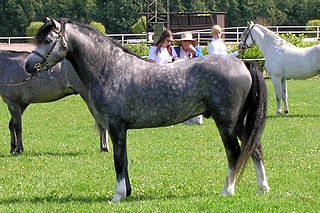
The Welsh Pony and Cob is a group of four closely-related horse breeds including both pony and cob types, which originated in Wales. The four sections within the breed society for the Welsh breeds are primarily distinguished by height, and also by variations in type: the smallest Welsh Mountain Pony ; the slightly taller but refined Welsh Pony of riding type popular as a children's show mount; the small but stocky Welsh Pony of Cob Type, popular for riding and competitive driving; and the tallest, the Welsh Cob, which can be ridden by adults. Welsh ponies and cobs in all sections are known for their good temperament, hardiness, and free-moving gaits.

Western pleasure is a western style competition at horse shows that evaluates horses on manners and suitability of the horse for a relaxed and slow but collected gait cadence, along with calm and responsive disposition. The horse is to appear to be a "pleasure" to ride, smooth-moving and very comfortable. Most light horse breeds in the United States and Canada may compete in western pleasure classes, either in open competition or at shows limited to a single breed. However, horse conformation and temperament play a role in this event, and hence animals of stock horse breeds that are calm, quiet, have collected, soft gaits and the strong muscling required to sustain slow, controlled movement are the most competitive.

The Hunter division is a branch of horse show competition that is judged on the horse's performance, soundness and when indicated, conformation, suitability or manners. A "show hunter" is a horse that competes in this division.
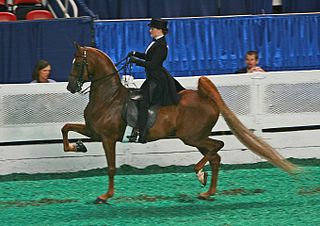
Saddle seat is a style of horse riding within the category of English riding that is designed to show off the high action of certain horse breeds. The style developed into its modern form in the United States, and is also seen in Canada and South Africa. To a much lesser extent, it is ridden with American horse breeds in Europe and Australia.
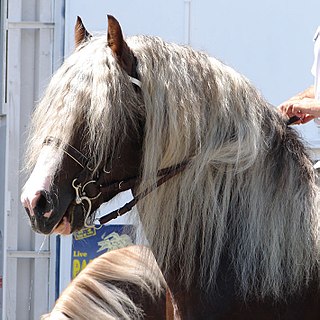
On horses, the mane is the hair that grows from the top of the neck of a horse or other equine, reaching from the poll to the withers, and includes the forelock or foretop. It is thicker and coarser than the rest of the horse's coat, and naturally grows to roughly cover the neck. Heredity plays a role, giving some horses a longer, thicker mane, and others a shorter, thinner one.
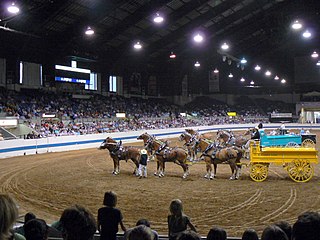
Draft horse showing refers to horse shows exclusively for horses of the draft horse breeds. In North America, though a small number of draft horses are also shown under saddle, the term "Draft horse showing" refers to a specific horse show competition that primarily features driving exhibitors presenting their horses to be judged in harness. Worldwide, some draft horse shows also feature riding classes.

Halter is a type of horse show class where horses are shown "in hand," meaning that they are led, not ridden, and are judged on their conformation and suitability as breeding stock. Depending on breed and geographic region, such events may be called "Halter," "In-Hand," "Breeding," "Model," or "Conformation" classes.

Driving, when applied to horses, ponies, mules, or donkeys, is a broad term for hitching equines to a wagon, carriage, cart, sleigh, or other horse-drawn vehicle by means of a harness and working them in this way. It encompasses a wide range of activities from pleasure driving, to harness racing, to farm work, horse shows, and even international combined driving.

Roadster is a type of driving competition for horses and ponies where the horse and exhibitor appear in equipment similar to that used in harness racing. It is derived from the historical use of certain horses hitched to light carts that traveled quickly from one place to another, often racing on ordinary dirt roads, hence the name. The term is also used to describe the horse used for such competition. Horses pull a light sulky and drivers wear racing silks. However, the exhibitors do not race. Instead, they perform in an arena at horse shows at trotting gaits that include a slow jog, a medium speed "road gait," and a rapid and long-strided but controlled trot referred to as showing "at speed." Animals are evaluated on performance and manners.

The show hack is a type of ridden show horse, exhibited to a standard first established in England.
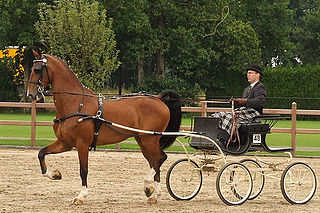
The Dutch Harness Horse, or Tuigpaard, is a warmblood breed of fine driving horse that has been developed in the Netherlands since the end of World War II. Their studbook is kept by the Koninklijk Warmbloed Paardenstamboek Nederland or KWPN. The breed is based on the native Groningen and Gelderland horses, which were formerly indispensable in agriculture and transportation services. Strict selection procedures and a clear breeding aim enabled breeders to produce a refined, high-stepping horse within a few decades. While with 40 sires and fewer than 2,000 broodmares the population is not large, Dutch Harness Horses are highly recognizable. In the past few years, a handful have come to North America, where they are used as sport horses and saddle seat horses alike.

Fine harness is a type of driving competition seen at horse shows, that feature light, refined horses with high action. Popular breeds in this event include the American Saddlebred, Morgan, Arabian, Dutch Harness Horse, and Hackney (horse).
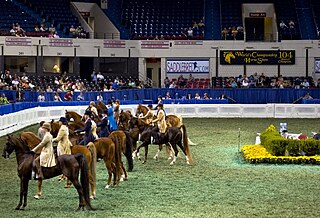
The World's Championship Horse Show, held at the Kentucky State Fairgrounds in Louisville, Kentucky, in Freedom Hall, is a large horse show that includes the American Saddlebred, Hackney pony, Dutch Harness Horse, and Standardbred breeds. It is usually held annually in late August, coinciding with the dates of the Kentucky State Fair and in the middle of the show season for the three breeds. Any horse or rider who wins there earns the title of World's Champion, and a second-place finish is identified with a Reserve World's Championship title. In addition to the WC and RWC titles, a horse can also earn the World's Grand Championship (WGC) or World's Championship of Champions (WCC) title. The winner of a championship class which requires a qualifier is given one of these titles.

Pleasure driving is a horse show class seen in the United States, which features light breeds of horses and ponies hitched to a two or four-wheeled show cart. Horses are driven at a walk and two speeds of trot, generally designated as a working or regular trot and an extended "strong" trot. Many horse breeds compete in Pleasure driving. Most classes are judged on the horse's manners, performance, quality and conformation.
The Pinto Horse Association of America (PtHA) registers horses, utility horses, ponies and miniature horses of various pedigrees with certain kinds of pinto coat colors. The word pinto is Spanish for "paint." In general terms, pinto can apply to any horse marked with unpigmented pink-skinned, white-haired areas on its coat. The Pinto Horse Association of America provides the owners and riders of pintos with a show circuit and a breed organization. The primary requirement for PtHA registration is coat color; the pinto is not a true breed, but a color breed.

The American Shetland Pony is an American breed of pony. It derives from the traditional Shetland Pony from the Shetland Isles of Scotland, but as a result of cross-breeding with other horse and pony breeds, is taller and more elegant. It does not have the thick coat of the traditional Shetland, and in conformation is more similar to the Hackney Pony, with some Arab influence. It is the most numerous pony breed in the United States; numbers in 1994 were estimated at over 50,000. It is one of two American pony breeds derived from the traditional Shetland, the other being the Pony of the Americas.





















